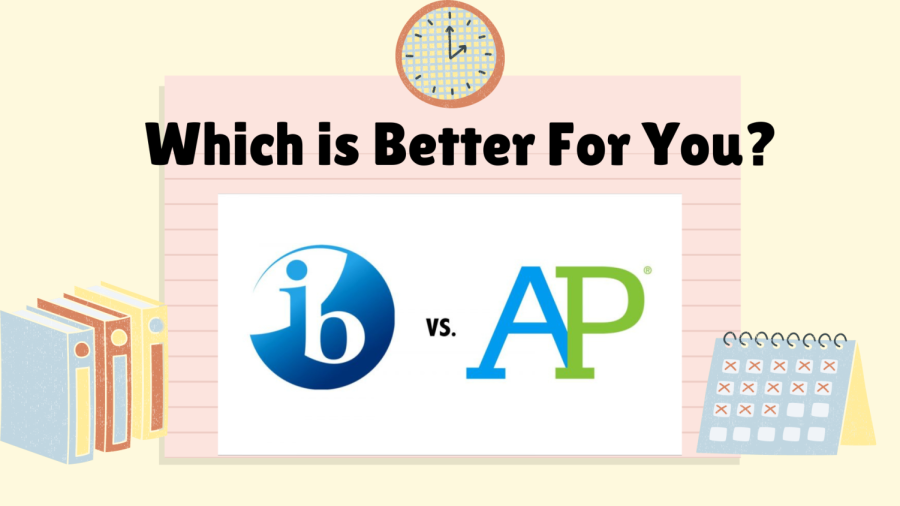AP Classes vs. IB Classes
October 7, 2022
When choosing between AP and IB classes, or choosing both, there is often hesitation. A large number of students tend to refrain from taking these courses due to many factors, such as the difficulty of the courses and the time they consume. Here is a guide that explains, compares, and contrasts AP and IB classes to help you decide which is best for you.
Overview of AP
There are 38 Advanced Placement (AP) courses in a plethora of subjects ranging from mathematics to art. You can choose classes based on your strengths, but all of these classes are academically demanding. You may receive college credit based on your exam score, but college credit is not guaranteed. Unlike International Baccalaureate (IB) exams, you do not have to enroll in a particular AP course to take the exam. Similar to IB, these classes are weighted, and therefore can potentially improve your grade point average (GPA). The exam fee is $96, but there is sometimes a fee waiver if you find yourself in a difficult financial situation. These classes can also be beneficial for the college admissions process as they show colleges that you academically challenged yourself while in high school. Furthermore, these classes are college-content based, meaning that they prepare you well for college.
Some downsides to AP classes are that they are extremely time-consuming because of the workload, which could limit social activities because of a lack of free time. Many competitive schools also don’t accept AP credit. AP classes could also hurt your GPA if you choose a class that you are not as strong in, or that you have no interest in and you end up failing. Another disadvantage is that students tend to focus on passing the exam, rather than actually mastering the content and skills that these courses are designed to teach.
Overview of IB
The International Baccalaureate (IB) program is a prestigious international educational program that aims to develop students into global citizens and intellectual thinkers. There are two pathways in this program: partial IB and full IB. Partial IB, also known as IB course candidacy, is a pathway in which students take one or more IB classes in their subject of choice. Additionally, these students must complete all required coursework, including Internal Assessments (IA’s), and score a passing grade (4 or higher) on the IB exam.
Full IB, or IB Diploma students, must take one course from each of the five different subject areas: Language and Literature, Language Acquisition, Individuals and Societies, Sciences, and Mathematics, and take an additional class from one of these subject areas, or from the Arts. IB Diploma candidates must take three, but no more than four higher level (HL) courses and score an average of 4 on all of these exams. The rest of their courses will be at the standard level (SL).
In addition, students must take another class, Theory of Knowledge (TOK), which explores why we know the things we know. Students must also complete the Extended Essay which is a 4,000-word research-based essay, along with an 18-month commitment to the Creativity, Activity, and Service (CAS) requirement. Each IB subject is assessed on a scale of 1-7, with 7 being the highest. Additionally, students can earn 3 more points from TOK and the Extended Essay. Each IB Diploma candidate must reach a total of 24 points in order to receive the diploma. Students going on the Full IB path must have a serious commitment to the program as it brings about excessive workload and possibly sleepless nights.
Similarities and Differences
Like AP classes, IB classes are also academically rigorous, offer the potential for college credit based on exam scores, offer a GPA boost, prepare you for college, and show college admission officers that you challenged yourself throughout high school. Some things to take into consideration when signing up for these classes are that IB exams are more expensive than AP exams. Whereas AP exams are $96, IB exams are $119. Both of these programs are extremely time-consuming, but IB is said to be more time-consuming due to all of the components of the IB Diploma. Although there is a wide variety of AP classes, Adams does not offer much because of the focus on the IB program.
While you may think that IB limits extracurricular involvement because of the CAS requirements, you may not have to limit your extracurricular commitments as much as you think. You also must be enrolled in an IB class to take the exam for that course, unlike AP exams. Like AP, for partial IB you have the option to choose a subject that you’re strong in, but with the full IB Diploma pathway, you must take classes in all subject areas, regardless of your strengths. These students must be willing to challenge themselves in both their strong and weak areas. However, you can choose your weaker subjects as SLs and stronger subjects as HLs. Another huge benefit of IB is that if you want to go to an international school, IB is internationally recognized and accredited. IB has a more prominent focus on personal development, community involvement, critical thinking, global awareness, mindset, leadership, and international applications.
Ultimately, AP and IB classes have their similarities and differences. These classes can offer a plethora of advantages and disadvantages, so it is important to choose what’s best for you. Whether you are willing to challenge yourself, or you’re trying to get into a competitive university, it is a good idea to try out these classes to pursue your interests and explore your capabilities.



